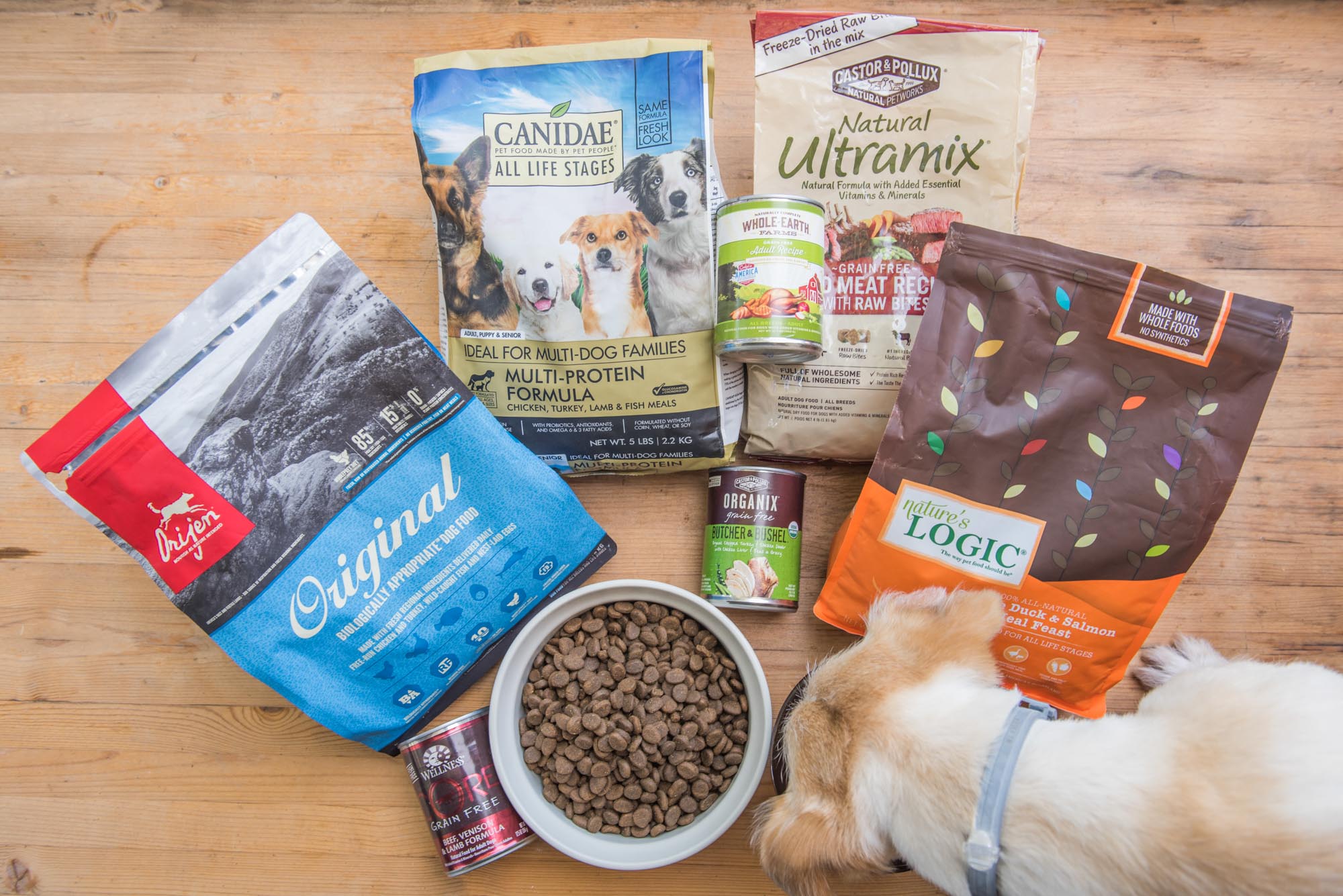
The Best Dog Food
We researched over fifty brands of canned and dry dog food and compared them to federal pet food standards. Castor & Pollux – Organix Butcher & Bushel stands out as the best of the canned foods we studied. Nature’s Logic is a superb dry food that combines three meat and fish meals with 19 whole fruits and vegetables. And for the best grain-free dry dog food, we chose Orijen – Original.
We researched over fifty brands of canned and dry dog food and compared them to federal pet food standards. Castor & Pollux – Organix Butcher & Bushel stands out as the best of the canned foods we studied. Nature’s Logic is a superb dry food that combines three meat and fish meals with 19 whole fruits and vegetables. And for the best grain-free dry dog food, we chose Orijen – Original.
Table of contents
- Compare the best dog foods
- Pet food standards
- What do dogs need in their diet?
- Packaging and labeling
- What makes the best dog food?
- Best canned food: Castor & Pollux – Organix
- Best dry food: Nature’s Logic
- Best grain-free dry food:Orijen
- Others we recommend
- Others we don’t recommend
- The bottom line
Compare the best dog foods
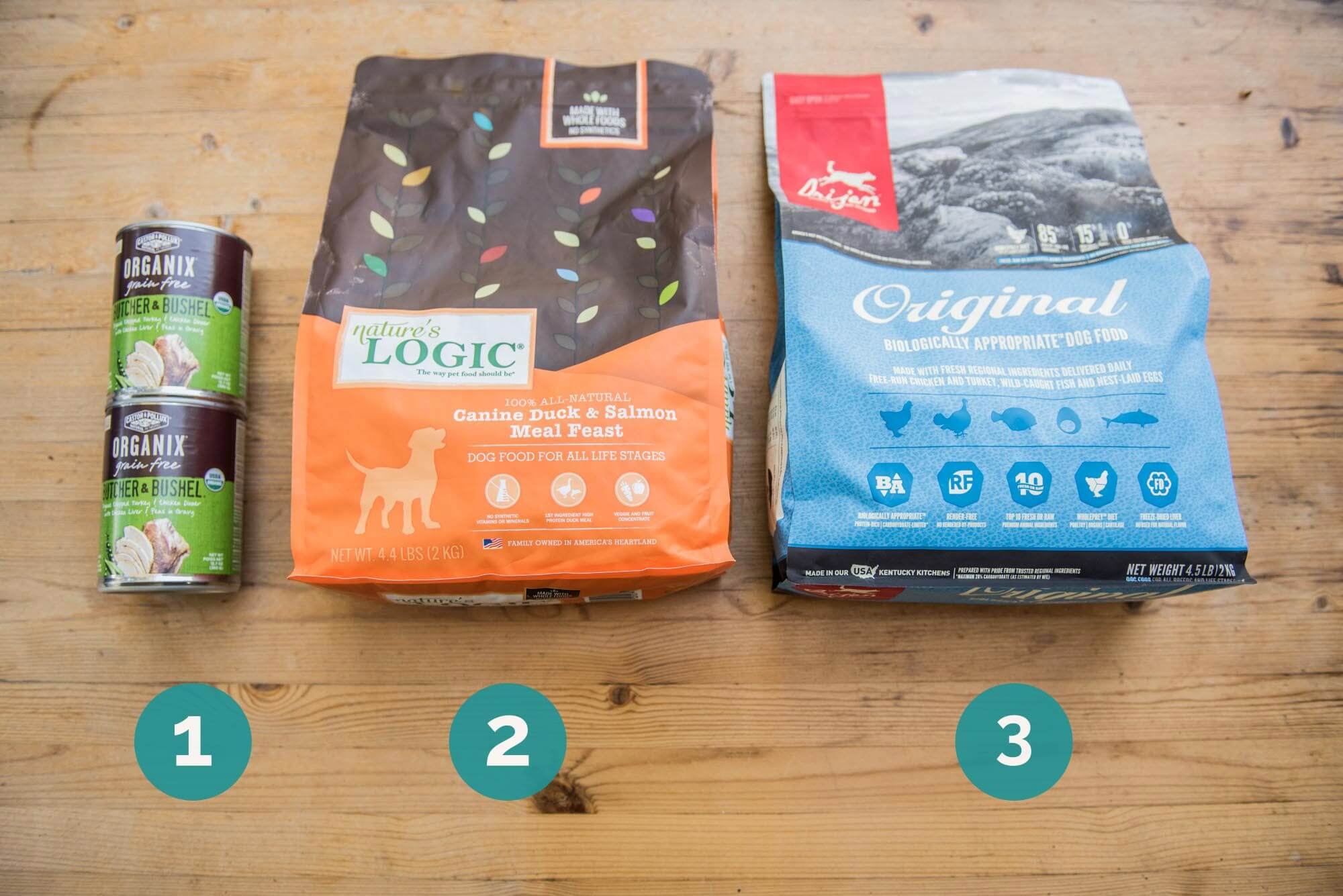
| Product | Price | Protein (Dry Matter Percentage) | Fat (Dry Matter Percentage) | Calories |
|---|---|---|---|---|
| 1. Castor & Pollux - Organix Butcher & Bushel | $2.99/12.7 oz. can | 42% | 22% | 345/can |
| 2. Nature’s Logic | $16.95/4.4 lb. bag | 40% | 19% | 417/8 oz. |
| 3. Orijen - Original | $23.99/4.5 lb. bag | 43% | 20% | 449/8 oz. |
| 4. Canidae - Multi-Protein Formula | $15.99/5 lb. bag | 26% | 16% | 468/8 oz. |
| 5. Whole Earth Farms - Grain-Free Adult Recipe | $2.49/12.7 oz. can | 43% | 27% | 444/can |
| 6. Wellness CORE - Natural Grain-Free | $3.29/12.7 oz. can | 54% | 36% | 508/can |
| 7. Castor & Pollux - Natural Ultramix | $19.99/4 lb. bag | 42% | 17% | 365/8 oz. |

Pet food standards
The U.S. Food and Drug Administration (FDA) works hand-in-hand with the Association of American Feed Control Officials (AAFCO) in regulating pet food standards. The AAFCO is a voluntary membership organization of local, state and federal agencies who regulate the sale and distribution of animal feed and pet food.
The AAFCO’s panel of scientists, veterinarians and experts on animal nutrition devised industry-wide standards for the ingredients used in manufacturing pet foods. For any pet food to be deemed certified by the AAFCO, ingredients must be:
- Species appropriate
- Proven safe
- Nutritionally adequate
Together with the AAFCO, the FDA enforces the required labeling of pet foods. All pet foods must be labeled with:
- Ingredients
- Manufacturer’s name and address
- Guaranteed analysis (such as protein, fiber, fat, etc.)
- Nutritional adequacy statement
- Feeding directions
- Calorie statement
A manufacturer of dog food must comply with the FDA’s regulations to sell their product. As long as the manufacturer follows the rules for labeling, they are free to add virtually any ingredient to their dog food.
What do dogs need in their diet?
As with humans, a dog’s diet is the foundation of good health. There are foods that can heal a dog, foods that harm a dog, and foods that do both. A frequent term used by veterinarians is “species appropriate,” which means the type of food the animal consumes in the wild. Since dogs and wolves share 99.9% of DNA, a species appropriate diet for a dog would be similar to a wolf’s diet: high protein, high moisture and low carbohydrates.
Although it’s popular to think a dog is omnivorous — and it certainly does seem like they eat anything — they have not evolved from their carnivorous origins. Dogs require meat in their diet, despite the fad of feeding them just vegetables and whole grains. Their digestive system breaks down raw meat, bone, offal and fur into nutrients and then passes waste material quickly.
We’re not advocating feeding bones, internal organs and fur to your dog, but the nutrients these body parts supply should be integrated in your dog’s diet. Reputable dog food manufacturers strive to make foods that meet your dog’s nutritional needs. There are, however, many dog food manufacturers — household names, no less — that plump up their product with unnamed meats, bulky grains and additives to save costs.
Changing your dog’s food
Conventional wisdom is that you should never change a dog’s food. According to veterinarian Dr. Karen Becker, that’s like being told as a child that the only thing you can eat for the rest of your life is oatmeal.
In the wild, canines have a smorgasbord of foods at their disposal, so if you’ve been feeding your dog the same canned and/or dry food for years, there’s a good chance that he/she is bored with it. A quick change, however, may cause digestive distress. There’s a definite procedure for changing your dog’s diet, but it will be nutritionally beneficial for him/her to switch foods periodically.
Grain-free diet
No doubt you see a lot of savvy marketing for “grain-free” dog foods. It’s true that grains add unnecessary carbohydrates, but as dogs evolved, their digestive systems adapted to processing grains. (The exception is whole ground corn, which is difficult for dogs to digest and process.)
Some breeds, however, have a genetic predilection for gluten and other food allergies, so a grain-free diet is necessary for them to thrive.
In 2018, the FDA launched a study into possible links between grain-free diets and canine heart disease. Removing grains from pet foods eliminates taurine, an important amino acid for both cats and dogs. The Journal of the American Veterinary Medical Association reports that the FDA’s study is not just focused on grain-free diets, however, but also on the possible detrimental effects of replacing grains with legumes.
Jme Thomas is the Executive Director of Motley Zoo Animal Rescue, and she advises that since the FDA’s study has caused some concern in the pet industry, you might consider feeding your dog a food that has small amounts of grain. However, If your dog is allergic to grain, then it’s best to simply add a taurine supplement to his/her food.
How dog food is made
Canned
The primary ingredients of canned dog food are fresh meat and meat by-products, which include the cleaned carcass and internal organs of the slaughtered animal. The meat is frozen and either cut into chunks or ground. It is then steamed in water or broth, and the cooked meat is then combined with other ingredients, such as vegetables, grains, vitamins and minerals. A starch or thickener is added to gel the mixture together. The mixture is packed into individual cans, vacuum-sealed and sterilized in a heating chamber.
Dry food
Fresh or frozen meat and meat by-products are combined with ground grains, fats, vitamins, minerals and meals derived from ground bone or ground dehydrated meat or meat by-products. This mixture, resembling bread dough, is forced through an extruder, which cooks and cuts it into shapes. The pieces are then oven-dried, cooled and sprayed with flavor enhancers and preservatives.
Freeze-dried
Cut raw meat is placed inside a vacuum chamber, which freezes the meat solid. The chamber’s temperature is gradually increased and pressurized. The meat’s frozen internal liquid converts to vapor and is extracted. Freeze-dried food may be fed as is or rehydrated.
Dehydrated
Conversely, dehydration involves a heat process of removing moisture from meat. Low heat is slowly applied to the raw product until it is completely dried. Dehydrated foods must be rehydrated before feeding.
Packaging and labeling
Since dog food is marketed to owners and not their dogs, most of the manufacturer’s deception and specious claims are found on the product’s packaging.
The majority of dog food packaging — if not all of it —is plastered with bright and bold colors and mouth-watering photographs of roasted or raw meats and vegetables, sometimes ladled with gravy or cross-hatched with barbecue grill marks. These enticing images are obviously intended to draw your eyes to the packaging.
Next, the manufacturer will grab you with marketing catch phrases on the bag or can, such as “increases vitality,” “vibrant maturity,” or “proactive health.” Also you’ll see “premium,” “super-premium” and “ultra-premium.”
Unfortunately, there are no set standards for using these phrases, and a company will label their product to appeal to the consumer’s emotions and conscience. Although there are dog food manufacturers who are indeed using higher-quality ingredients, others are simply marking up the price of their product for the inclusion of ingredients that have no proven higher nutritional value.
AAFCO labeling rules
The FDA and AAFCO cannot enforce truth in advertising. However, dog food manufacturers are required to use specific wording for the percentages of meat in their products. Below are the standardized phrases and their definitions as dictated by the AAFCO.
95-percent rule: Ninety-five percent — not including the water added for processing — of the product must be the named ingredient, for example, beef or chicken. If the water is counted in the total percentage, then the named ingredient must comprise 70-percent of the total. If the name includes two ingredients — for example, “Beef ‘n Liver Dog Food” — they must comprise 95% of the total weight with the first ingredient listed having predominance.
25-percent or “dinner” rule: If the named ingredients comprise at least 25% of the product (not including water for processing), it must be labeled as “dinner. For example, ‘Beef Dinner for Dogs” must only contain at least 25% of beef in the total weight of the product. If two ingredients are listed, like “Beef ‘n Liver Dinner,” the second named ingredient must weigh only 3% of the total.
3-percent or “with” rule: This rule was originally created for advertising the inclusion of a minor ingredient, such as cheese, in the food. The AAFCO has modified the rule so that the word “with” indicates that 3% of the ingredient comprises the total weight. So for example, “Dog Food With Beef” means there is only 3% beef total in the food.
Flavor: No percentage is required for this word to be used, but it must contain an amount that is detectable. “Beef Flavor Dog Food” may have beef as an ingredient, but more than likely it is beef meal, beef by-products or a “digest,” a concentrated flavor enhancer derived from the liquid of boiled-down meats.
Natural: The AAFCO defines “natural” as meaning ingredients that are derived solely from animal, plant or mineral that have not been processed using chemicals or chemical additives. A product may be labeled as “100-percent natural” or “all-natural” only if it does not contain synthetic ingredients.
Organic: The same requirements established by the U.S. Department of Agriculture (USDA) for foods consumed by humans apply to dog foods. Ingredients must be produced by approved methods without synthetic fertilizers, irradiation or genetic engineering. The USDA does not consider organic foods to be necessarily healthier or more nutritious than conventionally produced foods.
How to read the label
Reading the label of the canned or dry food is the only way to really know whether it is the best food for your dog. The FDA enforces federal regulations for information that must be printed on every pet food label. Individual states may elect to follow the guidelines established by the AAFCO, which are more specific.
Each label should include:
- Proper identification of the product
- Proper listing of ingredients
- Manufacturer’s name and address
- Guaranteed analysis.
- Feeding directions
- Calorie statements
Ingredients
As we discussed in our best dog treat review, the ingredients in pet foods are not always easily identifiable. However, the AAFCO’s standards and definitions will help you understand exactly what’s in the dog food you buy.
All ingredients are required to be listed in order by weight, and the primary ingredients (those with the most weight) will be the first four or five that are listed. Since dog food manufacturers know that you want to feed meat to your dog, in most cases meat will be the first ingredient listed.
Bear in mind, however, that the water needed to cook the meat in canned food is included in the weight. In canned food, water or broth for processing is often the second — hence, the second weightiest — ingredient.
The same rule applies to dry food before processing. You might see chicken listed as the first ingredient, but once that chicken’s been cooked and its moisture (nearly 75% of the meat’s weight) has been removed, the chicken’s weight has been reduced to approximately 20%.
There are three types of meat that are used in canned and dry dog food.
Meat: Defined as “the clean flesh of slaughtered mammals and is limited to muscle tissue attached to the skeleton by tendons with or without the accompanying and overlying fat and the portions of the skin, sinew, nerve and blood vessels which normally accompany the flesh.”
The species of animal from which the meat was harvested must also be identified. “Slaughtered mammals” is very broad and could include meat you would never consider feeding to your beloved pet.
A major controversy in the pet food industry is known as “4-D meat.” The FDA has strict laws for the use of raw 4-D meat — diseased, dying, down, dead — in pet foods. A significant number of veterinarians and pet food nutritionists don’t believe the FDA is able to fully enforce these laws with all suppliers of meat. They warn that pet food labeled “meat” or “animal” could be harmful to your pet’s health.
As a general rule, never purchase a pet food that does not identify the species of animal meat or meat by-products used.
Meat by-products: Rendered animal parts deemed not suitable for human consumption. They include carcasses, internal organs, heads, feet, hair and unhatched eggs. Although by-products are not considered esthetically pleasing by many people, they are oftentimes safe and nutritious for dogs.
Meat meal and by-product meal: Meat and meat by-products, including bone, from which fat and moisture have been removed. Bone meal is similar to meat and by-product meals, but it can include entire carcasses. Unlike meat and meat by-products, animals other than cattle, sheep and goats may be used without identification on the label.
Ingredients to beware
The following list are ingredients that are frequently added to canned and dry dog foods. Veterinarians and pet nutritionists warn that these ingredients should not be fed to your dog. Some of the ingredients can cause your dog immediate harm, while others could affect your dog’s health over the long term.
Generic animal fat: If the animal fat isn’t identified on the label, you’ll have no idea from what species of animal the fat has been trimmed.
BHA and BHT: Banned in most countries for potential links to cancer, these chemical preservatives are still added to certain dog foods in the U.S. and Canada.
Artificial coloring: Red, blue and yellow dyes have been added to appeal visually to you; your dog won’t care.
Corn syrup, fructose and sucrose: These sugars and other sweeteners are added to make lower-grade ingredients taste better.
Xylitol: A sugar substitute used in products like chewing gum, this is toxic to dogs.
Propylene glycol: This is a chemical food additive notable for its use in “safe” antifreeze. It’s often used in semi-moist dry dog food as a humectant. Although propylene glycol has been banned from cat food, it’s still allowed in dog food (and for human consumption at low levels).
Ethoxyquin: First created by Monsanto as a pesticide and a food preservative, ethoxyquin has been linked to cancer. Its use in human food is heavily restricted, but it’s used in dog foods as a preservative for fish and fish meal. A manufacturer of dog food is not required to list ethoxyquin on the label if fish or fish meal was purchased from a supplier outside of the U.S.
Guaranteed analysis
Manufacturers are required to list the minimum amount of crude protein and crude fat and maximum amount of crude fiber and moisture on all dog food labels. “Crude” does not refer to the quality of the nutrient but to the method of estimating the quantity of the nutrient.
These percentages, however, vastly differ between canned dog food and dry dog food. For example, canned dog food might have 12% minimum crude protein and dry dog food might have 36%. You would assume the dry food is higher in protein than the canned food. In actuality, that’s not accurate.
Canned food has quadruple the amount of moisture of dry food, and so to make a meaningful calculation of nutrients, the FDA advises using the “dry matter basis.” This may seem overly complex, but it’s easy to do and the only way of determining how nutritious a canned or dry food is.
Step 1: Subtract the percentage of moisture listed on the canned food’s label from 100. As an example, the label on the canned food lists moisture as 72%. Subtract 72 from 100, leaving you with 28. This is now the percentage of dry matter in the canned food.
Step 2: Divide the percentage of protein listed on the label — in our example, 12% — by the dry matter. So 12 divided by 28 equals (rounded off) .43.
Step 3: Multiply that result by 100, and this will now give you the actual percentage of protein in the canned food.
Repeat the calculation with the dry food, and compare them side by side. You now have an accurate representation of how much protein each contains.
Nutritional adequacy statement
Any dog food manufacturer that claims its product is “complete and balanced” must be labeled with the AAFCO nutritional adequacy statement. The food has been tested using AAFCO Feeding Trial Protocols under strict guidelines.
On the label, look for the following wording:
“…formulated to meet the nutritional levels established by the AAFCO Dog Food Nutrition Profiles for All Life Stages.”
If you don’t see the AAFCO’s nutritional adequacy statement, the product has not met the AAFCO’s stringent standards.
“Made in the USA”
By the Federal Trade Commission’s definition, “made in the USA” means that all or virtually all of a product has been made in the U.S. The FTC is less strict, however, about pet foods. A manufacturer of dog food may indeed process its product in the U.S., but it may source ingredients outside of the U.S.
In 2007, melamine in wheat gluten imported from China and used in canned dog food resulted in thousands of canine deaths. The FDA issued a recall of all the pet foods made in the U.S. that used the imported wheat gluten. Currently the FDA is still investigating and studying what happened but has yet to issue regulations for importation of ingredients used in the manufacture of pet food.
The best you can do to ensure that the dog food you buy is made with U.S.-sourced ingredients is check whether the company has taken the Association for Truth in Pet Food’s Pledge to Quality and Origin of Ingredients.
What makes the best dog food?
Canned
The primary ingredients are an identified whole meat: The first ingredient should be an identified whole meat. The second ingredient is usually water or broth for processing. (Some of the canned foods we researched actually had water as the first ingredient.) The third ingredient should also be another identified whole meat or meat meal. If you see brown rice, white rice, corn or barley as the third ingredient, that’s too much filler that will add carbohydrates.
Whole unprocessed vegetables and limited grains: The nutrients, vitamins and antioxidants of whole foods will survive processing better than ground grains and vegetables. For example, “peas” are more nutritious than “pea flour.”
High protein, high moisture, low carbohydrates: The AAFCO recommends a minimum of 22.5% protein and a minimum of 8.5% fat for puppies, and a minimum of 18% protein and 5.5% fat for adult dogs. The AAFCO does not measure carbohydrates, but estimates them by calculating other components, including crude fiber.
AAFCO nutritional statement: Look for a statement on the can’s label that the food “provides complete and balanced nutrition for all life stages.”
Dry dog food
The first three ingredients are an identified whole meat: Manufacturers know that you want to feed meat to your dog, so it will be listed first. If you see “chicken,” that’s great. Remember that the chicken loses up to 75% of its weight during processing. So the second ingredient should be another identified whole meat, and the third ingredient should be meat or a meat meal.
Whole vegetables and limited whole grains: Whole vegetables and grains will retain more nutritional value than vegetable or grain flours during processing. Grains add carbohydrates, so look for dry foods that have grains lower on the list of ingredients.
Appropriate protein-to-fat ratio: The percentages of protein to fat are dependent on your dog’s age and weight. The AAFCO recommends a daily consumption for a healthy adult dog as a minimum of 18% protein and 5.5% fat. The best dry dog foods we researched overall had a 2.5-to-1 protein-to-fat ratio.
AAFCO nutritional statement: “Provides complete and balanced nutrition for all life stages” should be on the food’s label.
Best canned food: Castor & Pollux – Organix
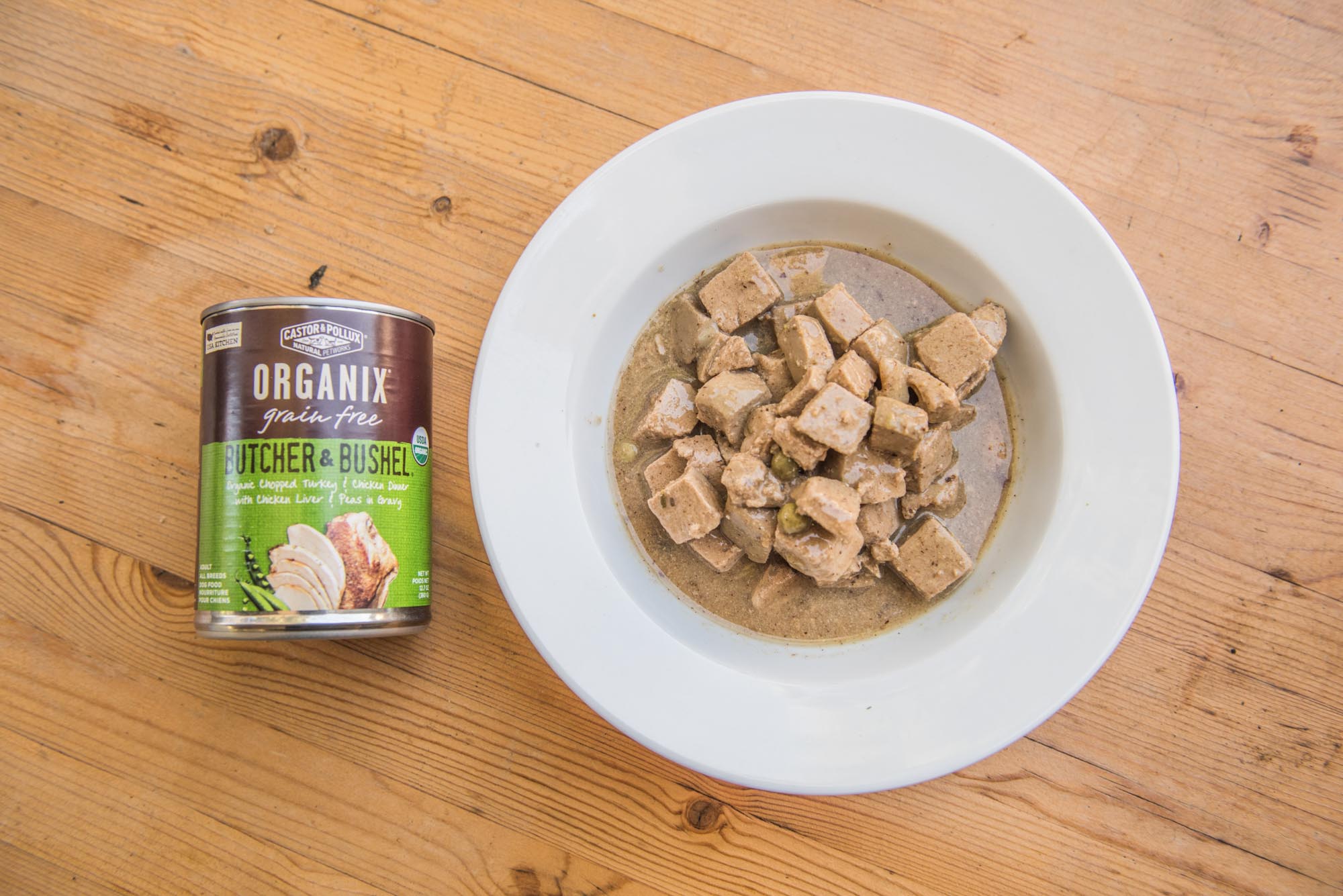
Our recommendations for best canned dog food are based on research and the analysis of twenty-three products that can be purchased at grocery stores, pet supply stores and online. We’ve consulted veterinarians and pet food nutrition experts for their opinions about what criteria canned dog food should meet to be considered exceptional.
Castor & Pollux has several blends of their excellent canned dog foods. The Butcher & Bushel blends are predominantly organic meats with whole vegetables and use less water and broth for processing than their other Organix recipes.
Castor & Pollux’s Chopped Turkey and Chicken Dinner is high in protein and moisture and low in carbohydrates, which is exactly what you want in a canine food. Primary ingredients are meat: organic turkey, organic chicken and organic chicken liver. Peas, potatoes and blueberries are the vegetables and fruit. There’s also some flaxseed, which is a rich source of healthy fat and antioxidants.
The Castor & Pollux Organix brand is USDA-certified 100% organic and verified by The Non-GMO Project as produced in accordance with best practices for GM avoidance. It also bears the AAFCO nutritional statement on the label.
There are three more grain-free Organix Butcher & Bushel recipes: Chicken Wing and Thigh (which actually has chicken bone attached to the meat), Carved Turkey Dinner and Shredded Chicken Dinner. All of the Butcher & Bushel recipes have an abundance of meat in the first four ingredients. The regular Organix recipes and other grain-free recipe have more brown rice or starchy vegetables as primary ingredients.
Using the dry basis method, the Organix Chopped Turkey and Chicken dinner has 42% protein and 22% fat, which is an acceptable protein-to-fat ratio per the AAFCO’s guidelines for an adult-maintenance diet.
Best dry food: Nature’s Logic
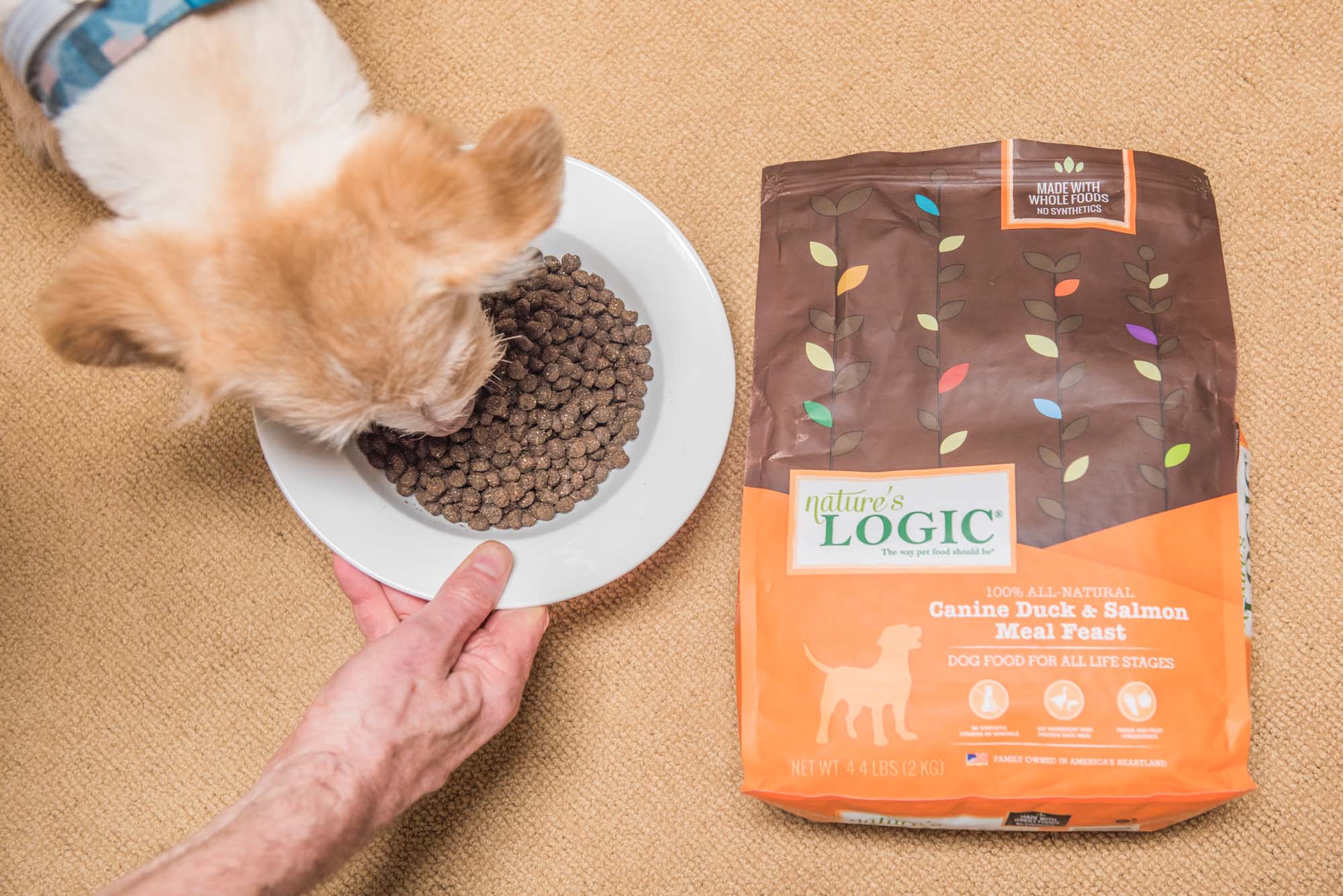
Our recommendations for best dry dog food are based on the analysis and comparison of 27 products that can be purchased at big-box stores, supermarkets, pet supply stores and online.
We’ve selected Nature’s Logic as the best dry dog food. Nature’s Logic has nine formulas of dry dog food. All the recipes have non-GMO millet in their first five ingredients, so they’re not grain-free. Millet, however, is an excellent source of phosphorus, B vitamins and iron, and it’s a carbohydrate that’s easier for dogs to digest.
There is no corn, soy, wheat, rice, peas or lentils in any of Nature’s Logic’s dry foods. Peas and lentils are often added to dog foods as a grain replacement. Peas, lentils and other legumes are currently being studied by the FDA as possible links to canine heart disease, so we applaud Nature’s Logic excluding them from their recipes.
The Duck & Salmon Meal Feast has three meat meals — duck, turkey and salmon — rather than whole meat, which do not diminish in moisture and weight when processed. So you’re actually getting more meat in Nature’s Logic that you would in other dry dog foods that list meat as the first ingredient
Also added to the ingredients are 19 different dried fruits and vegetables with antioxidant properties and menhaden fish meal, which is high in Omega-3 fat content.
Nature’s Logic has eight other varieties of dry dog food, but the majority have chicken (or other identified animal) fat as the third ingredient and pumpkin seed as the fourth ingredient. We prefer the Duck & Salmon recipe to the others because it has three meat meals. Only the Venison and the Rabbit recipes have more than one meat meal as a primary ingredient.
Using the dry method calculation, Nature’s Logic duck and salmon recipe has 40% protein and 19% fat, which is an appropriate protein-to-fat ratio by AAFCO standards. The Nature’s Logic label states that its food provides complete and balanced nutrition for all life stages and complies with AAFCO nutritional adequacy standards.
Best grain-free dry food: Orijen – Original
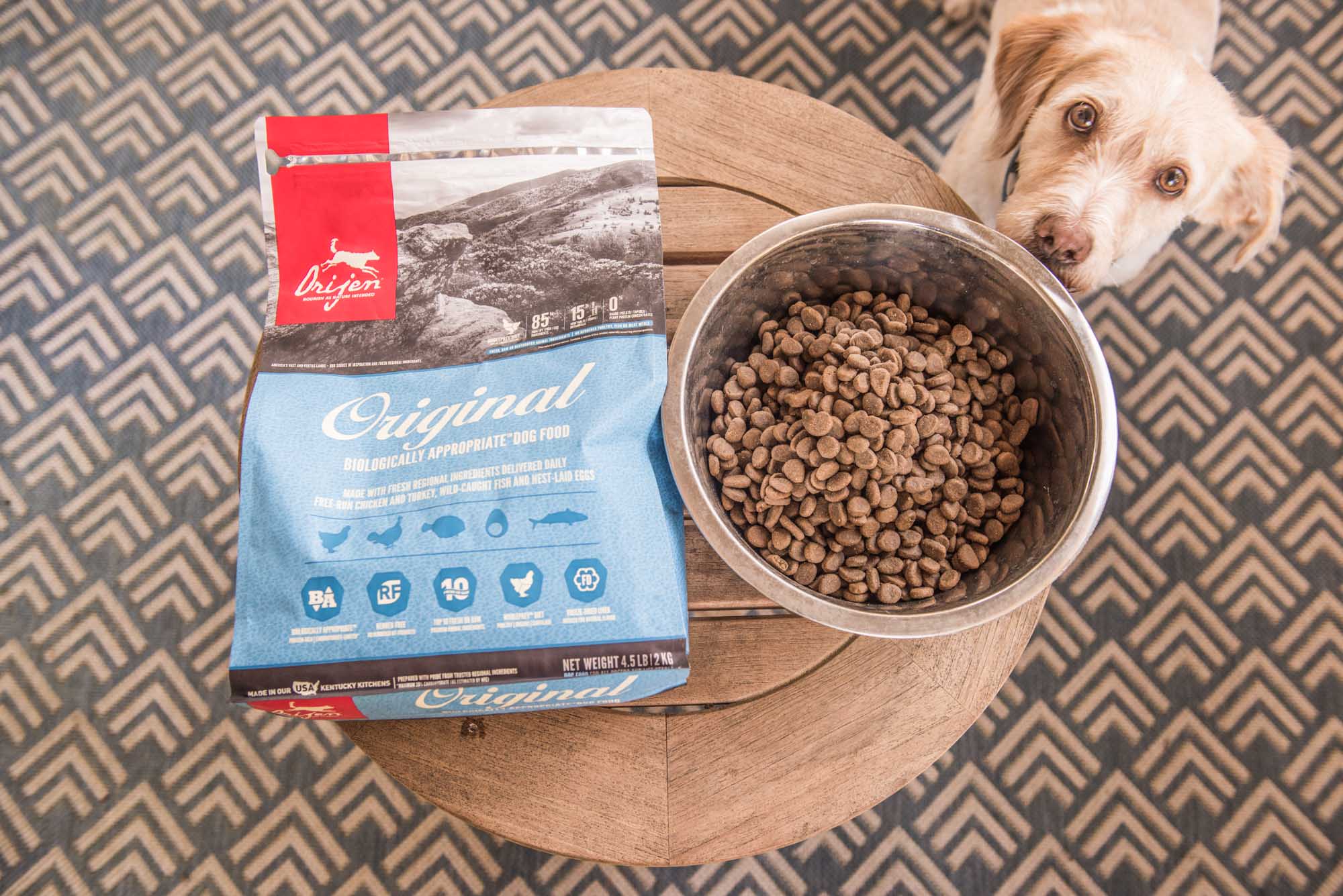
Orijen is a Canadian company that takes great pride in not using meat meals in their foods. Based on our analysis, we would agree with Orijen’s marketing that their Original Dry Dog Food is indeed biologically appropriate. Not only does Orijen dehydrate their fresh meats, but they’re also up-front about the fact that poultry bones and cartilage are ground up in the mix.
Eighty-five percent of the Orijen – Original is composed of meat, and the remaining 15% includes vegetables, fruits and herbs. The only additive is a zinc chelate, which helps promote a healthy immune system.
The Orijen – Original is grain free, and like other grain-free dog foods, a variety of legumes — lentils, pinto beans, green peas, navy beans and chickpeas — are added instead. As we noted earlier, the FDA is currently studying the links between grain-free and legume-heavy diets and canine heart disease.
Orijen has eight recipes in total, two of which are designed for puppies. Orijen states that all of their foods are 85% whole or dried meats, and we don’t doubt that. For the Original recipe, three and three-quarters pounds of fresh, raw and dehydrated meats, fish and whole eggs are used to make a 4.5-pound bag of food. However, during processing, the actual weight of the raw meats and fish is greatly diminished.
That said, the rest of Orijen’s dehydrated meat and fish ingredients make up for the loss, and it’s why their dog foods are so protein-packed. With its abundance of meat, Orijen – Original has 43% protein and 20% fat, which is an above-average amount of protein to fat.
Orijen – Original (and all Orijen dog foods) is formulated to meet the nutritional standards established by the AAFCO for all stages of canine life. It’s an excellent dry dog food, but it’s about one-third more expensive than other high-quality grain-free brands. In our estimation, it’s the best grain-free dry dog food and worth the price.
Other products we recommend
Canidae – All Life Stages

Canidae has four formulas in their All Life Stages dry dog food, and of the four, the Multi-Protein Formula recipe is the best. Canidae doesn’t use corn, wheat or soy, but there is a significant amount of brown rice, white rice and rice bran in all of their formulas, usually as the second, third and fourth ingredients.
The Multi-Protein Formula, however, is the exception in this brand and lists chicken meal, turkey meal and lamb meal as its first three ingredients. Ocean fish meal and salmon oil are far down the list but are most likely in the same proportions as the preceding millet, barley, oatmeal and flaxseed.
Protein is calculated at 26%, which is below the average of other dry dog food, and fat is 16%, which is about average.
Whole Earth Farms – Grain Free

Whole Earth Farms – Grain-Free Adult Recipe is a canned food and has meat in its first five ingredients: chicken, chicken broth, turkey, chicken liver and whitefish. Peas, potatoes, carrots and apples round out this well-balanced dog food. Its dry matter protein is 43% and fat is 27%. This recipe blend has about the same acceptable protein-to-fat ratio as the Castor & Pollux – Organix Butcher & Bushel.
Whole Earth Farms has three other blends that also have meats and fish as primary ingredients. The company also makes a variety of high-quality meat stews. These, however, have broths as their second and third ingredients and consequently don’t meet all the criteria of what makes the best canned dog food.
Wellness CORE – Natural Grain Free

Wellness has a large variety of canned dog foods, which they call “paté.” Their CORE blends are packed with meat or fish as primary ingredients.
Their Beef, Venison & Lamb Formula lists beef, beef broth, beef liver, pork liver, venison and lamb as the first six ingredients, followed by chicken meal (another source of meat) and antioxidant fruits and vegetables. This recipe is packed with protein (calculated by the dry method basis) at 54%, but its fat is 36%, which is higher than the AAFCO average.
Castor & Pollux – Natural Ultramix – Red Meat Recipe

Castor & Pollux has several Ultramix dry dog food formulas, and they all have meat and meat meal as their primary ingredients. The Red Meat Recipe is grain-free and has beef, pork meal and lamb meal as its first three ingredients. Some of the beef’s weight is lost in the processing, but this is compensated with the addition of freeze-dried raw beef nuggets.
The Red Meat Recipe is packed with additional meats and fish meal, vegetables and antioxidant fruits. The only ingredient that’s not identified is “natural flavor.” The AAFCO defines natural flavoring as “materials treated with heat, enzymes and/or acids to form concentrated natural flavors.” This is such a high quality dog food, we would prefer that Castor & Pollux stated what’s in their natural flavor.
As might be expected, the Red Meat Recipe has lots of protein, 42%, and surprisingly low fat, 17%. Similar to Orijen – Original, this is an above average protein-to-fat ratio.
Other products we do not recommend
As Dr. Karen Beckers says “a dog needs to thrive not just survive.” The following canned and dry dog foods are popular and have been around for years. They meet the minimum AAFCO standards. Their ingredients are unidentified meat and meat by-products, starch and other fillers or unnecessary additives.
Cesar Sunrise: Grilled Steak & Eggs Flavor: The primary ingredients in this particular recipe are water, beef by-products, animal (unidentified) liver, meat (unidentified) by-products, beef and chicken by-products. You certainly do not want to feed your dog unidentified meat. The AAFCO is very specific about how meat should be identified on the label.
Alpo Prime Cuts: This popular and cheap canned food’s first listed ingredient is water, which means that it is the heaviest ingredient by weight. The next ingredient is unidentified poultry, which, as defined by the AAFCO, is cleaned meat, skin and bones of any bird considered to be poultry. Unfortunately, the manufacturer is not required to state what type of bird is used.
The third most abundant ingredient is unidentified meat by-products. Packed with wheat gluten, soy flour, modified corn starch (as a thickener) and artificial coloring, we advise you to pass this one by.
Pedigree Choice Cuts: Again, the first and heaviest ingredient is water, followed by chicken, meaning meat and bone. But then the third primary ingredient is — like Alpo — unidentified meat by-products. This canned food is also full of unnecessary additives, like sodium nitrate, food coloring and gluten.
Purina Dog Chow: This long-time favorite is representative of what dry dog food should not be. On Amazon, a 52-pound bag is less than $27, which indicates how cheap the ingredients must be. Dog Chow’s number one ingredient is corn. The next four ingredients are unidentified poultry by-product meal, corn gluten meal, beef fat, ground rice and soybean meal. Other highly objectionable ingredients are beef, egg and chicken flavors, unidentified poultry and pork digest (concentrated liquid from boiled-down animal parts) and four artificial colorants.
Kibbles ‘n Bits: This popular dry dog food is another example of a cheaply made product with corn as its main ingredient. Throw in corn syrup, fat and unidentified animal digest, and this low-grade dry dog food is about as nutritious as fast food.
The bottom line
Your dog’s age, breed, health and activity level will factor into which dog food is the best for him/her. There are many dog foods available, but not all of them might be right for your dog, so you should discuss feeding options with your veterinarian.
Our recommendations are based on analyzing the ingredients and nutritional statements of more than 50 canned and dry dog foods. We compared them to the test protocols and standards established by the AAFCO for determining “complete and balanced nutrition at all life stages.”
For the best canned dog food, we recommend Castor & Pollux – Organix Butcher & Bushel. The chopped turkey and chicken dinner is grain free and has three organic meats as its primary ingredients combined with vegetables and antioxidant fruits.
Our choice for best dry dog food is Nature’s Logic – Canine Duck & Salmon Meal Feast. Its three meat-based (duck, turkey and salmon) meals are mixed with concentrates of fruits and vegetables. Nature’s Logic adds no artificial vitamins or minerals and uses no synthetic colors or flavors.
For the best grain-free dry dog food, we selected Orijen – Original, a Canadian-made dog food that is composed of 85 percent rendered and dehydrated meats and fish. High in protein and low in carbohydrates, this excellent dog food is biologically and species appropriate.
More Reviews
CatGuru - Heavy Duty Cat Litter Mat
Cat Dancer
Shark - NV350
Litter-Robot 3 Connect Review (Testing a $549+ Automatic Litter Box)
Litter-Robot 3 Connect
Healthy Paws
Safety 1st - Bamboo Gate
The Best Outdoor Security Camera Systems
Nest - Cam Outdoor
Litter-Robot 4 vs. 3 Comparison: We Tested Both!
Litter-Robot 4
The 8 Best Dog Shedding Brushes
Hertzko Self-Cleaning Brush
DELOMO - Pet Hair Roller
The Best Automatic Litter Boxes
Pet Zone - SmartScoop
Litter-Robot 4 Review: Cat-Testing a $700 Litter Box
Litter-Robot 4




















